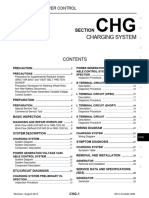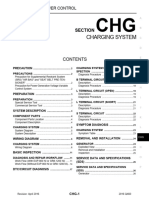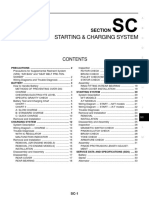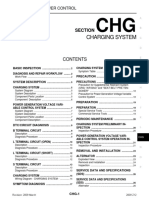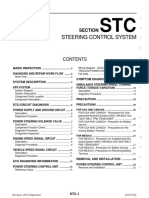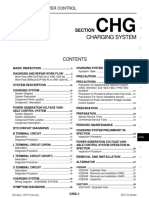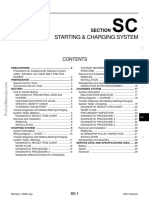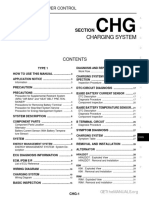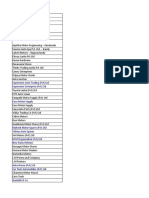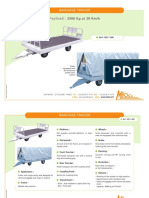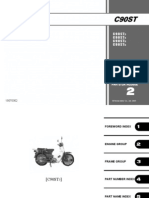Starting & Charging System: Section
Starting & Charging System: Section
Uploaded by
q6md2qdmhpCopyright:
Available Formats
Starting & Charging System: Section
Starting & Charging System: Section
Uploaded by
q6md2qdmhpOriginal Title
Copyright
Available Formats
Share this document
Did you find this document useful?
Is this content inappropriate?
Copyright:
Available Formats
Starting & Charging System: Section
Starting & Charging System: Section
Uploaded by
q6md2qdmhpCopyright:
Available Formats
STARTING & CHARGING SYSTEM
K ELECTRICAL
STARTING & CHARGING SYSTEM
SECTION SC B
E
CONTENTS
PRECAUTIONS .......................................................... 2 DIAGNOSTIC PROCEDURE 1 ........................... 17 F
Precautions for Supplemental Restraint System DIAGNOSTIC PROCEDURE 2 ........................... 18
(SRS) “AIR BAG” and “SEAT BELT PRE-TEN- MINIMUM SPECIFICATION OF CRANKING
SIONER” .................................................................. 2 VOLTAGE REFERENCING COOLANT TEM- G
Precautions for Battery Service ................................ 2 PERATURE ......................................................... 18
Wiring Diagrams and Trouble Diagnosis .................. 2 Removal and Installation ........................................ 19
PREPARATION ........................................................... 3 REMOVAL ........................................................... 19
H
Special Service Tools ............................................... 3 INSTALLATION ................................................... 19
Commercial Service Tools ........................................ 3 Disassembly and Assembly .................................... 20
BATTERY .................................................................... 4 INSPECTION AFTER DISASSEMBLY ................ 20
How to Handle Battery ............................................. 4 CHARGING SYSTEM ............................................... 21 I
METHODS OF PREVENTING OVER-DIS- System Description ................................................. 21
CHARGE ............................................................... 4 MALFUNCTION INDICATOR .............................. 21
CHECKING ELECTROLYTE LEVEL .................... 5 Wiring Diagram — CHARGE — ............................. 22 J
SPECIFIC GRAVITY CHECK ............................... 5 Trouble Diagnoses with Battery/Starting/Charging
CHARGING THE BATTERY ................................. 6 System Tester ......................................................... 23
Trouble Diagnoses with Battery/Starting/Charging DIAGNOSTIC RESULT ITEM CHART ................ 24
SC
System Tester .......................................................... 7 WORK FLOW ...................................................... 25
DIAGNOSTIC RESULT ITEM CHART .................. 8 PRELIMINARY INSPECTION ............................. 26
Removal and Installation .......................................... 9 DIAGNOSTIC PROCEDURE 1 ........................... 26
REMOVAL ............................................................. 9 DIAGNOSTIC PROCEDURE 2 ........................... 27 L
INSTALLATION ..................................................... 9 DIAGNOSTIC PROCEDURE 3 ........................... 27
STARTING SYSTEM ................................................ 10 DIAGNOSTIC PROCEDURE 4 ........................... 28
System Description ................................................ 10 Removal and Installation ........................................ 29 M
M/T MODEL ........................................................ 10 REMOVAL ........................................................... 29
A/T MODEL ..........................................................11 ALTERNATOR PULLEY INSPECTION ............... 30
Wiring Diagram — START — ................................. 12 INSTALLATION ................................................... 30
M/T MODEL ........................................................ 12 Disassembly and Assembly .................................... 31
A/T MODEL ......................................................... 14 SERVICE DATA AND SPECIFICATIONS (SDS) ...... 32
Trouble Diagnoses with Battery/Starting/Charging Battery .................................................................... 32
System Tester ........................................................ 15 Starter ..................................................................... 32
DIAGNOSTIC RESULT ITEM CHART ................ 15 Alternator ................................................................ 32
WORK FLOW ...................................................... 16
Revision: 2004 December SC-1 2005 350Z
PRECAUTIONS
PRECAUTIONS PFP:00011
Precautions for Supplemental Restraint System (SRS) “AIR BAG” and “SEAT
BELT PRE-TENSIONER” AKS00C6K
The Supplemental Restraint System such as “AIR BAG” and “SEAT BELT PRE-TENSIONER”, used along
with a front seat belt, helps to reduce the risk or severity of injury to the driver and front passenger for certain
types of collision. This system includes seat belt switch inputs and dual stage front air bag modules. The SRS
system uses the seat belt switches to determine the front air bag deployment, and may only deploy one front
air bag, depending on the severity of a collision and whether the front occupants are belted or unbelted.
Information necessary to service the system safely is included in the SRS and SB section of this Service Man-
ual.
WARNING:
● To avoid rendering the SRS inoperative, which could increase the risk of personal injury or death
in the event of a collision which would result in air bag inflation, all maintenance must be per-
formed by an authorized NISSAN/INFINITI dealer.
● Improper maintenance, including incorrect removal and installation of the SRS, can lead to per-
sonal injury caused by unintentional activation of the system. For removal of Spiral Cable and Air
Bag Module, see the SRS section.
● Do not use electrical test equipment on any circuit related to the SRS unless instructed to in this
Service Manual. SRS wiring harnesses can be identified by yellow and/or orange harnesses or
harness connectors.
Precautions for Battery Service AKS00C6L
Before disconnecting the battery, lower both the driver and passenger windows. This will prevent any interfer-
ence between the window edge and the vehicle when the door is opened/closed. During normal operation, the
window slightly raises and lowers automatically to prevent any window to vehicle interference. The automatic
window function will not work with the battery disconnected.
Wiring Diagrams and Trouble Diagnosis AKS00C6M
When reading wiring diagrams, refer to the following:
● GI-15, "How to Read Wiring Diagrams"
● PG-4, "POWER SUPPLY ROUTING CIRCUIT" for power distribution circuit
When performing trouble diagnosis, refer to the following:
● GI-11, "HOW TO FOLLOW TEST GROUPS IN TROUBLE DIAGNOSES"
● GI-27, "How to Perform Efficient Diagnosis for an Electrical Incident"
Revision: 2004 December SC-2 2005 350Z
PREPARATION
PREPARATION PFP:00002
A
Special Service Tools AKS0098M
Tool number
Description
Tool name B
J-44373 Model 620
Battery/Starting/Charging system
tester C
D
SEL403X
F
Commercial Service Tools AKS0098N
Tool number G
Description
Tool name
Power tool Loosening bolts and nuts
H
PBIC0190E
SC
Revision: 2004 December SC-3 2005 350Z
BATTERY
BATTERY PFP:AYBGL
How to Handle Battery AKS0098O
CAUTION:
● If it becomes necessary to start the engine with a booster battery and jumper cables, use a 12-volt
booster battery.
● After connecting battery cables, ensure that they are tightly clamped to battery terminals for good
contact.
METHODS OF PREVENTING OVER-DISCHARGE
The following precautions must be taken to prevent over-discharging
a battery.
● The battery surface (particularly its top) should always be kept
clean and dry.
● The terminal connections should be clean and tight.
● At every routine maintenance, check the electrolyte level.
This also applies to batteries designated as “low maintenance”
and “maintenance-free”.
MEL040F
● When the vehicle is not going to be used over a long period of
time, disconnect the battery cable from the negative terminal.
ELA0349D
● Check the charge condition of the battery.
Periodically check the specific gravity of the electrolyte. Keep a
close check on charge condition to prevent over-discharge.
MEL042F
Revision: 2004 December SC-4 2005 350Z
BATTERY
CHECKING ELECTROLYTE LEVEL
WARNING: A
Never allow battery fluid to come in contact with skin, eyes, fabrics, or painted surfaces. After touch-
ing a battery, never touch or rub your eyes until you have thoroughly washed your hands. If acid con-
tacts eyes, skin or clothing, immediately flush with water for 15 minutes and seek medical attention. B
● Remove the cell plug using a suitable tool.
● Add distilled water up to the MAX level.
C
E
MEL043F
Sulphation
F
A battery will be completely discharged if it is left unattended
for a long time and the specific gravity will become less than
1.100. This may result in sulphation on the cell plates.
To determine if a battery has been “sulphated”, note its voltage G
and current when charging it. As shown in the figure, less cur-
rent and higher voltage are observed in the initial stage of
charging sulphated batteries. H
A sulphated battery may sometimes be brought back into ser-
vice by means of a long, slow charge, 12 hours or more, fol-
lowed by a battery capacity test.
I
PKIA2353E
SPECIFIC GRAVITY CHECK
1. Read hydrometer and thermometer indications at eye level. J
2. Use the chart below to correct your hydrometer reading accord-
ing to electrolyte temperature.
SC
MEL042FA M
Hydrometer Temperature Correction
Battery electrolyte temperature °C (°F) Add to specific gravity reading
71 (160) 0.032
66 (150) 0.028
60 (140) 0.024
54 (130) 0.020
49 (120) 0.016
43 (110) 0.012
38 (100) 0.008
32 (90) 0.004
27 (80) 0
21 (70) −0.004
Revision: 2004 December SC-5 2005 350Z
BATTERY
Battery electrolyte temperature °C (°F) Add to specific gravity reading
16 (60) −0.008
10 (50) −0.012
4 (40) −0.016
−1 (30) −0.020
−7 (20) −0.024
−12 (10) −0.028
−18 (0) −0.032
Corrected specific gravity Approximate charge condition
1.260 - 1.280 Fully charged
1.230 - 1.250 3/4 charged
1.200 - 1.220 1/2 charged
1.170 - 1.190 1/4 charged
1.140 - 1.160 Almost discharged
1.110 - 1.130 Completely discharged
CHARGING THE BATTERY
CAUTION:
● Never “quick charge” a fully discharged battery.
● Keep the battery away from open flame while it is being charged.
● When connecting the charger, connect the leads first, then turn on the charger. Never turn on the
charger first, as this may cause a spark.
● If battery electrolyte temperature rises above 55 °C (131 °F), stop charging. Always charge battery
at a temperature below 55 °C (131 °F).
Charging Rates
Amps Time
50 1 hour
25 2 hours
10 5 hours
5 10 hours
Never charge at more than 50 ampere rate.
NOTE:
The ammeter reading on your battery charger will automatically decrease as the battery charges. This indi-
cates that the voltage of the battery is increasing normally as the state of charge improves. The charging amps
indicated above refer to initial charge rate.
● If, after charging, the specific gravity of any two cells varies more than 0.050, the battery should be
replaced.
Revision: 2004 December SC-6 2005 350Z
BATTERY
Trouble Diagnoses with Battery/Starting/Charging System Tester AKS0098P
A
CAUTION:
When working with batteries, always wear appropriate eye protection.
NOTE:
● To ensure a complete and thorough diagnosis, the battery, starter and generator test segments must be B
done as a set from start to finish.
● If battery surface charge is detected while testing, the tester will prompt you to turn on the headlamps to
remove the surface charge. C
● If necessary, the tester will prompt you to determine if the battery temperature is above or below 0 °C (32
°F). Choose the appropriate selection by pressing the up or down arrow button, then press “ENTER” to
make the selection. D
1. Turn off all loads on the vehicle electrical system. Clean or repair
as necessary.
2. Visually inspect the battery, battery terminals and cable ends E
with ignition switch in “OFF” position.
NOTE:
The contact surface between the battery terminals, cable ends F
and tester leads must be clean for a valid test. A poor connec-
tion will prevent testing and a “CHECK CONNECTION” mes-
sage will appear during the test procedures. If this occurs, clean
the battery terminals, reconnect them and restart the test. G
3. Connect the red tester lead clamp to the positive battery termi- SEL404X
nal, and the black to the negative terminal.
H
4. The tester will turn on automatically. Using the arrow keys,
select “IN-VEHICLE” on the tester and then press the “ENTER”
key.
I
SC
SEL405X
5. Locate the battery type and rating stamped or written on the top
case of the battery to be tested. L
NOTE:
The battery type and rating will have either of the following.
CCA: Cold Cranking Amps (490 CCA, 550 CCA, etc.) M
JIS: Japanese Industrial Standard.
Battery is stamped with a number such as:
80D26L: 80 (rank of output), D (physical size-depth), 26 (width
in cm). The last character L (post configuration) is not input into
the tester.
The tester requires the rating for the battery be entered exactly SEL406X
as it is written or stamped on the battery. Do not attempt a CCA
conversion for JIS stamped batteries. JIS must be input directly.
6. Using the arrow and “ENTER” keys alternately, select the battery type and rating.
NOTE:
The tester lists five choices; CCA, JIS, IEC, DIN, and EN. Only use CCA or JIS.
Revision: 2004 December SC-7 2005 350Z
BATTERY
7. Press “ENTER” to begin the test. Diagnosis results are dis-
played on the tester. Refer to SC-8, "DIAGNOSTIC RESULT
ITEM CHART" .
SEL407X
8. Press “ENTER”, then test output code is displayed. Record the
test output code on the repair order.
9. Toggle back to the “DIAGNOSTIC SCREEN” for test results.
NOTE:
● If necessary, the tester will ask the user to determine if the
battery has just been charged. Choose the appropriate selec-
tion by pressing the up or down arrow button and then press
the “ENTER” button to make the selection.
● When testing a battery installed in a vehicle that has recently
been driven, select “BEFORE CHARGE”.
SEL576X
● If the battery has just been slow charged due to a “CHARGE
& RETEST” decision by the tester, and the tester asks the user “BEFORE CHARGE/AFTER
CHARGE”, select “AFTER CHARGE”.
DIAGNOSTIC RESULT ITEM CHART
Diagnostic item Service procedure
Battery is OK, go to “Trouble Diagnoses”, “STARTING SYSTEM”. Refer to SC-15, "Trouble Diagnoses with
GOOD BATTERY
Battery/Starting/Charging System Tester" .
Replace battery.
Before replacing battery, clean the battery cable clamps and battery posts. Perform battery test again with
REPLACE BATTERY
Battery/Starting/Charging system tester. If second test result is “Replace Battery”, then do so. Perform bat-
tery test again to confirm repair.
Replace the battery. Perform battery test again with Battery/Starting/Charging system tester to confirm
BAD CELL-REPLACE
repair.
GOOD-RECHARGE Perform the slow battery charging procedure. (Initial rate of charge is 10A for 12 hours.)
Perform the slow battery charging. (Initial rate of charge is 10A for 12 hours.)
Perform battery test again with Battery/Starting/Charging system tester to confirm repair.
CHARGE & RETEST
NOTE:
If the tester asks the user “BEFORE CHARGE/AFTER CHARGE”, select “AFTER CHARGE”.
Revision: 2004 December SC-8 2005 350Z
BATTERY
Removal and Installation AKS0098Q
REMOVAL A
CAUTION:
Before disconnecting the battery, lower both the driver and passenger windows. This will prevent any
interference between the window edge and the vehicle when the door is opened/closed. During normal B
operation, the window slightly raises and lowers automatically to prevent any window to vehicle inter-
ference. The automatic window function will not work with the battery disconnected.
1. Remove hoodledge cover (right). C
PKIA1919E F
2. Disconnect both battery cables from terminals.
CAUTION:
G
When disconnecting, disconnect the battery cable from the
negative terminal first.
3. Remove clips of cowl top cover (right) and it raises to the up
side. H
4. Remove battery fix frame mounting nuts and battery fix frame.
5. Remove relay box from bracket.
I
6. Remove battery.
SKIB1149E
INSTALLATION J
Installation is the reverse order of removal.
CAUTION:
When connecting, connect the battery cable to positive terminal first. SC
Battery fix frame mounting nut
: 3.9 N·m (0.4 kg-m, 35 in-lb)
L
Battery cable tightening nut
: 5.4 N·m (0.55 kg-m, 48 in-lb)
M
Revision: 2004 December SC-9 2005 350Z
STARTING SYSTEM
STARTING SYSTEM PFP:23300
System Description AKS0098R
M/T MODEL
Power is supplied at all times:
● through 40A fusible link (letter M , located in the fuse and fusible link block)
● to ignition switch terminal 1,
● through 10A fuse (No. 71, located in the IPDM E/R)
● to CPU of IPDM E/R,
● through 15A fuse (No. 78, located in the IPDM E/R)
● to CPU of IPDM E/R.
With the ignition switch in the ON or START position, power is supplied:
● to CPU of IPDM E/R, from battery direct
● through 10A fuse (No. 89, located in the IPDM E/R) and IPDM E/R terminal 25
● to clutch interlock switch terminal 1.
When the clutch pedal is depressed, power is supplied:
● through clutch interlock switch terminal 2
● to IPDM E/R terminal 53.
Ground is supplied:
● to IPDM E/R terminals 38, 50 and 60
● from grounds E17, E43 and F152.
Then starter relay is turn ON.
With the ignition switch in the START position, IPDM E/R is energized and power is supplied:
● from ignition switch terminal 5
● to IPDM E/R terminal 4 and
● through IPDM E/R terminal 3
● to starter motor terminal 1.
The starter motor plunger closes and provides a closed circuit between the battery and starter motor. The
starter motor is grounded to the engine block. With power and ground supplied, cranking occurs and the
engine starts.
Revision: 2004 December SC-10 2005 350Z
STARTING SYSTEM
A/T MODEL
Power is supplied at all times: A
● through 40A fusible link (letter M , located in the fuse and fusible link block)
● to ignition switch terminal 1,
B
● through 10A fuse (No. 71, located in the IPDM E/R)
● to CPU of IPDM E/R,
● through 15A fuse (No. 78, located in the IPDM E/R) C
● to CPU of IPDM E/R.
With the ignition switch in the ON or START position, power is supplied:
● to CPU of IPDM E/R, from battery direct. D
When the selector lever in the “P” or “N” position, power is supplied:
● from A/T assembly (TCM) terminal 9
● to IPDM E/R terminal 53. E
Ground is supplied:
● to IPDM E/R terminals 38, 50 and 60
F
● from grounds E17, E43 and F152.
Then starter relay is turn ON.
With the ignition switch in the START position, IPDM E/R is energized and power is supplied:
G
● from ignition switch terminal 5
● to IPDM E/R terminal 4 and
● through IPDM E/R terminal 3 H
● to starter motor terminal 1.
The starter motor plunger closes and provides a closed circuit between the battery and starter motor. The
starter motor is grounded to the engine block. With power and ground supplied, cranking occurs and the I
engine starts.
SC
Revision: 2004 December SC-11 2005 350Z
STARTING SYSTEM
Wiring Diagram — START — AKS0098S
M/T MODEL
TKWT1297E
Revision: 2004 December SC-12 2005 350Z
STARTING SYSTEM
SC
TKWT1298E
Revision: 2004 December SC-13 2005 350Z
STARTING SYSTEM
A/T MODEL
TKWM1314E
Revision: 2004 December SC-14 2005 350Z
STARTING SYSTEM
Trouble Diagnoses with Battery/Starting/Charging System Tester AKS0098T
A
NOTE:
To ensure a complete and thorough diagnosis, the battery, starter and generator test segments must be done
as a set from start to finish.
1. Turn off all loads on the vehicle electrical system. B
2. Perform battery test with Battery/Starting/Charging system
tester. Refer to SC-7, "Trouble Diagnoses with Battery/Starting/
Charging System Tester" . C
3. Press “ENTER” to begin the starting system test.
E
SEL408X
4. Start the engine.
F
SEL409X
I
5. Diagnostic result is displayed on the tester. Refer to SC-15,
"DIAGNOSTIC RESULT ITEM CHART" .
NOTE: J
● If the starter performs normally but the engine does not start,
perform engine diagnosis.
● For intermittent “NO CRANK” or “NO STARTER OPERA-
SC
TION” incidents, refer to SC-18, "DIAGNOSTIC PROCE-
DURE 2" .
L
SEL410X
DIAGNOSTIC RESULT ITEM CHART
M
Diagnostic item Service procedure
CRANKING VOLTAGE NORMAL
Go to SC-16, "WORK FLOW" .
CRANKING VOLTAGE LOW
Perform the slow battery charging procedure. (Initial rate of charge is 10A for 12 hours.) Per-
CHARGE BATTERY form battery test again with Battery/Starting/Charging system tester. Refer to SC-7, "Trouble
Diagnoses with Battery/Starting/Charging System Tester" .
Before replacing battery, clean the battery cable clamps and battery posts. Perform battery
test again with Battery/Starting/Charging system tester. Refer to SC-7, "Trouble Diagnoses
REPLACE BATTERY
with Battery/Starting/Charging System Tester" . If second test result is “REPLACE BAT-
TERY”, then do so. Perform battery test again to confirm repair.
Revision: 2004 December SC-15 2005 350Z
STARTING SYSTEM
WORK FLOW
SKIB0227E
*1 SC-15, "Trouble Diagnoses with Bat- *2 SC-18, "MINIMUM SPECIFICATION *3 SC-17, "Check “B” Terminal Circuit"
tery/Starting/Charging System OF CRANKING VOLTAGE REFER-
Tester" ENCING COOLANT TEMPERA-
TURE"
*4 SC-18, "Check “S” Connector Cir-
cuit"
Revision: 2004 December SC-16 2005 350Z
STARTING SYSTEM
DIAGNOSTIC PROCEDURE 1
Check “B” Terminal Circuit A
1. CHECK POWER SUPPLY FOR STARTER MOTOR “B” TERMINAL
1. Remove fuel pump fuse. B
2. Crank or start the engine (where possible) until the fuel pressure is released.
3. Turn ignition switch OFF.
C
4. Make sure that the starter motor “B” terminal E203 terminal 2 (B/GY) connection is clean and tight.
5. Check voltage between starter motor “B” terminal E203 terminal
2 (B/GY) and ground.
D
2 (B/GY) – Ground : Battery voltage
OK or NG
E
OK >> GO TO 2.
NG >> Check harness between the battery and the starter
motor for open circuit.
F
PKIA2842E
2. CHECK BATTERY CABLE CONNECTION STATUS (VOLTAGE DROP TEST) G
1. Shift A/T selector lever to “P” or “N” position. (A/T models)
Keep depressing clutch pedal fully. (M/T models) H
2. Check voltage between starter motor “B” terminal E203 terminal
2 (B/GY) and battery positive terminal.
I
2 (B/GY) – Battery positive terminal
When the ignition switch is : Less than 0.5 V
in START position
J
OK or NG
OK >> GO TO 3. PKIA2370E
NG >> Check harness between the battery and the starter SC
motor for poor continuity.
3. CHECK STARTER MOTOR GROUND CIRCUIT (VOLTAGE DROP TEST) L
1. Shift A/T selector lever to “P” or “N” position. (A/T models)
Keep depressing clutch pedal fully. (M/T models)
2. Check voltage between starter motor case and battery negative M
terminal.
Starter motor case – Battery negative terminal
When the ignition switch is : Less than 0.2 V
in START position
OK or NG
OK >> Starter motor “B” terminal circuit is OK. Further inspec- PKIA2786E
tion necessary. Refer to SC-16, "WORK FLOW" .
NG >> Check the starter motor case and ground for poor continuity.
Revision: 2004 December SC-17 2005 350Z
STARTING SYSTEM
DIAGNOSTIC PROCEDURE 2
Check “S” Connector Circuit
1. CHECK POWER SUPPLY FOR STARTER MOTOR “S” TERMINAL
1. Remove the fuel pump fuse.
2. Crank or start the engine (where possible) until the fuel pressure is released.
3. Turn ignition switch OFF.
4. Disconnect starter motor connector.
5. Shift A/T selector lever to “P” or “N” position. (A/T models)
Keep depressing clutch pedal fully. (M/T models)
6. Check voltage between starter motor harness connector F9 ter-
minal 1 (B/Y) and ground.
1 (B/Y) – Ground
When the ignition switch is : Battery voltage
in START position
OK or NG
OK >> “S” connector circuit is OK. Further inspection neces-
sary. Refer to SC-16, "WORK FLOW" .
NG >> Check the following.
PKIA2807E
● 40A fusible link (letter M , located in fuse and fusible
link block)
● Ignition switch
● Starter relay (within the IPDM E/R)
● Harness for open or short
MINIMUM SPECIFICATION OF CRANKING VOLTAGE REFERENCING COOLANT TEMPERA-
TURE
Engine coolant temperature Voltage [V]
−30 °C to −20 °C (−22 °F to −4 °F) 8.4
−19 °C to −10 °C (−2 °F to 14°F) 8.9
−9 °C to 0 °C (16 °F to 32 °F) 9.3
More than 1 °C (More than 34 °F) 9.7
Revision: 2004 December SC-18 2005 350Z
STARTING SYSTEM
Removal and Installation AKS0098U
PKIA3025E
1. Starter motor mounting bolt 2. Harness clip bracket 3. S terminal connector G
4. B terminal mounting nut 5. B terminal harness 6. Starter motor
7. Oil pan
H
REMOVAL
1. Open the driver and front passenger window, and then disconnect the battery cable from the negative ter-
minal. I
CAUTION:
Before disconnecting the battery, lower both the driver and passenger windows. This will prevent
any interference between the window edge and the vehicle when the door is opened/closed. Dur-
ing normal operation, the window slightly raises and lowers automatically to prevent any window J
to vehicle interference. The automatic window function will not work with the battery discon-
nected.
2. Remove engine undercover, using power tools. SC
3. Disconnect “S” connector.
4. Remove “B” terminal mounting nut.
L
5. Remove starter motor mounting bolts and harness connector
clip bracket, using power tools.
6. Remove starter motor downward from the vehicle.
M
PKIA1921E
INSTALLATION
Installation is the reverse order of removal.
CAUTION:
Be sure to tighten “B” terminal nut carefully.
Revision: 2004 December SC-19 2005 350Z
STARTING SYSTEM
Disassembly and Assembly AKS0098V
PKIA2814E
1. Magnetic switch assembly 2. Dust cover kit 3. Shift lever set
4. Center bracket (A) 5. Yoke assembly 6. Armature assembly
7. Brush holder assembly 8. Thrust washer 9. Rear cover assembly
10. Through-bolt 11. Internal gear 12. Planetary gear
13. Pinion shaft 14. Packing 15. Thrust washer
16. Center bracket (P) 17. E-ring 18. Pinion assembly
19. Ball bearing 20. Caul 21. Gear case assembly
INSPECTION AFTER DISASSEMBLY
Pinion/Clutch Check
1. Inspect pinion teeth.
● Replace pinion if teeth are worn or damaged. (Also check condition of ring gear teeth.)
2. Inspect reduction gear teeth.
● Replace reduction gear if teeth are worn or damaged. (Also check condition of armature shaft gear
teeth.)
3. Check to see if pinion locks in one direction and rotates smoothly in the opposite direction.
● If it locks or rotates in both directions, or unusual resistance is evident, replace.
Revision: 2004 December SC-20 2005 350Z
CHARGING SYSTEM
CHARGING SYSTEM PFP:23100
A
System Description AKS0098X
The alternator provides DC voltage to operate the vehicle's electrical system and to keep the battery charged.
The voltage output is controlled by the IC regulator. B
Power is supplied at all times
● through 10A fuse (No. 36, located in the fuse and fusible link block)
● to alternator terminal 4 (“S” terminal). C
“B” terminal supplies power to charge the battery and operate the vehicle's electrical system. Output voltage is
controlled by the IC regulator at terminal 4 (“S” terminal) detecting the input voltage.
The alternator is grounded to the engine block. D
With the ignition switch in the ON or START position, power is supplied
● through 10A fuse [No. 14, located in the fuse block (J/B)]
● to combination meter terminal 23 for the charge warning lamp. E
Ground is supplied with power and ground supplied
● to terminal 17 of combination meter
● through alternator terminal 3 (“L” terminal) F
● to alternator terminal 2 (“E” terminal)
● through grounds E212 and E213.
The charge warning lamp will illuminate. When the alternator is providing sufficient voltage with the engine G
running, the ground is opened and the charge warning lamp will go off.
If the charge warning lamp illuminates with the engine running, a malfunction is indicated.
H
MALFUNCTION INDICATOR
The IC regulator warning function activates to illuminate charge warning lamp, if any of the following symp-
toms occur while alternator is operating:
I
● Excessive voltage is produced.
● No voltage is produced.
J
SC
Revision: 2004 December SC-21 2005 350Z
CHARGING SYSTEM
Wiring Diagram — CHARGE — AKS0098Y
TKWT0985E
Revision: 2004 December SC-22 2005 350Z
CHARGING SYSTEM
Trouble Diagnoses with Battery/Starting/Charging System Tester AKS0098Z
A
NOTE:
To ensure a complete and thorough diagnosis, the battery, starter and alternator test segments must be done
as a set from start to finish.
Before starting, perform the preliminary inspection. Refer to SC-26, "PRELIMINARY INSPECTION" . B
1. Turn off all loads on the vehicle electrical system.
2. Perform battery and starting system test with Battery/Starting/
Charging system tester. C
3. Press “ENTER” to begin the charging system test.
4. Start engine.
D
E
SEL417X
5. Press “ENTER” until “LOADS OFF REV ENGINE 5 SEC” is dis- F
played.
6. Raise and hold the engine speed at 1,500 to 2,000 rpm for about
5 seconds, then return the engine to idle. G
Once the increase in engine rpm is detected, press “ENTER” to
continue.
NOTE: H
● If after 30 seconds an increase in engine idle speed is not
detected, “RPM NOT DETECTED” will display.
● Some engines may have a higher idle initially after starting,
particularly when the engine is cold. The tester may detect SEL418X I
this without any other action being taken. If this occurs, con-
tinue on with the testing process. The final results will not be affected.
7. The tester now checks the engine at idle and performs the J
DIODE/RIPPLE check.
8. When complete, the tester will prompt you to turn on the follow-
ing electrical loads. SC
● Heater fan set to highest speed. Do not run the A/C or wind-
shield defroster.
● Headlamp high beam L
● Rear window defogger
NOTE:
Do not run the windshield wipers or any other cyclical loads. SEL419X
M
9. Press “ENTER” to continue.
SEL420X
Revision: 2004 December SC-23 2005 350Z
CHARGING SYSTEM
10. Raise and hold the engine speed at 1,500 to 2,000 rpm for about
5 seconds, then return the engine to idle. Once the increase in
engine rpm is detected, press “ENTER” to continue.
NOTE:
If after 30 seconds an increase in engine idle speed is not
detected, “RPM NOT DETECTED” will be displayed. Press
“ENTER” to restart the test.
SEL421X
11. Diagnostic result is displayed on the tester. Refer to SC-24,
"DIAGNOSTIC RESULT ITEM CHART" .
SEL422X
12. Press “ENTER” then test output code is displayed. Record the
test output code on the repair order.
13. Toggle back to the “DIAGNOSTIC SCREEN” for test results.
SEL577X
DIAGNOSTIC RESULT ITEM CHART
Diagnostic item Service procedure
CHARGING SYSTEM NORMAL Charging system is normal and will also show DIODE RIPPLE test result.
NO CHARGING VOLTAGE
LOW CHARGING VOLTAGE Go to SC-25, "WORK FLOW" .
HIGH CHARGING VOLTAGE
DIODE RIPPLE NORMAL Diode ripple is OK and will also show CHARGING VOLTAGE test result.
Replace the alternator. Perform “DIODE RIPPLE” test again using Battery/Starting/Charging
EXCESS RIPPLE DETECTED
system tester to confirm repair.
DIODE RIPPLE NOT DETECTED Go to SC-25, "WORK FLOW" .
Revision: 2004 December SC-24 2005 350Z
CHARGING SYSTEM
WORK FLOW
A
SC
SKIB0527E
*1 SC-26, "Check “L” Terminal Circuit *2 SC-27, "Check “L” Terminal Circuit *3 SC-27, "Check “S” Terminal Circuit"
(Open)" (Short)"
*4 SC-28, "Check “B” Terminal Circuit" *5 SC-30, "ALTERNATOR PULLEY
INSPECTION"
Revision: 2004 December SC-25 2005 350Z
CHARGING SYSTEM
PRELIMINARY INSPECTION
1. CHECK BATTERY TERMINALS CONNECTION
Check if battery terminals are clean and tight.
OK or NG
OK >> GO TO 2.
NG >> Repair battery terminals connection.
2. CHECK FUSE AND FUSIBLE LINK
Check for blown alternator and combination meter fuses.
Unit Power source (Power supply terminals) Fuse No.
Alternator Battery (“S” terminal) 36
Combination meter Ignition switch ON (“L” terminal) 14
OK or NG
OK >> GO TO 3.
NG >> If fuse is blown, be sure eliminate cause of malfunction before installing new fuse.
3. CHECK “E” TERMINAL CONNECTION
Check if “E” terminal is clean and tight.
OK or NG
OK >> GO TO 4.
NG >> Repair “E” terminal connection.
4. CHECK ALTERNATOR DRIVE BELT TENSION
Check alternator drive belt tension. Refer to EM-13, "Checking Drive Belts" .
OK or NG
OK >> INSPECTION END
NG >> Repair as needed.
DIAGNOSTIC PROCEDURE 1
Check “L” Terminal Circuit (Open)
1. CHECK “L” TERMINAL CONNECTION
1. Turn ignition switch OFF.
2. Check if “L” terminal is clean and tight.
OK or NG
OK >> GO TO 2.
NG >> Repair “L” terminal connection. Confirm repair by performing complete Battery/Starting/Charging
system test.
Revision: 2004 December SC-26 2005 350Z
CHARGING SYSTEM
2. CHECK “L” TERMINAL CIRCUIT (OPEN) A
1. Disconnect alternator connector.
2. Apply ground to alternator harness connector F20 terminal 3 (W/
R) with ignition switch in the ON position. B
3 (W/R) – Ground : Charge warning lamp
should light up.
C
OK or NG
OK >> Go to SC-25, "WORK FLOW" .
NG >> Check the following. D
● Harness for open between combination meter and
alternator
SKIB0599E
● Harness for open between combination meter and E
fuse
● Charge warning lamp (Combination meter)
DIAGNOSTIC PROCEDURE 2 F
Check “L” Terminal Circuit (Short)
1. CHECK “L” TERMINAL CIRCUIT (SHORT) G
1. Turn ignition switch OFF.
2. Disconnect alternator connector.
H
3. Turn ignition switch ON.
Charge warning lamp should light up?
YES >> Check the following. I
● Harness for short between combination meter and alternator
● Charge warning lamp (Combination meter)
NO >> Go to SC-25, "WORK FLOW" . J
DIAGNOSTIC PROCEDURE 3
Check “S” Terminal Circuit
SC
1. CHECK “S” TERMINAL CONNECTION
1. Turn ignition switch OFF. L
2. Check if “S” terminal is clean and tight.
OK or NG
OK >> GO TO 2. M
NG >> Repair “S” terminal connection. Confirm repair by performing complete Battery/Starting/Charging
system test.
2. CHECK ALTERNATOR “S” TERMINAL CIRCUIT
1. Disconnect alternator connector.
2. Check voltage between alternator harness connector F20 termi-
nal 4 (LG/B) and ground.
4 (LG/B) – Ground : Battery voltage
OK or NG
OK >> Go to SC-25, "WORK FLOW" .
NG >> Harness for open between alternator and fuse.
SKIB0532E
Revision: 2004 December SC-27 2005 350Z
CHARGING SYSTEM
DIAGNOSTIC PROCEDURE 4
Check “B” Terminal Circuit
1. CHECK “B” TERMINAL CONNECTION
1. Turn ignition switch OFF.
2. Check if “B” terminal is clean and tight.
OK or NG
OK >> GO TO 2.
NG >> Repair “B” terminal connection. Confirm repair by performing complete Battery/Starting/Charging
system test.
2. CHECK ALTERNATOR “B” TERMINAL CIRCUIT
Check voltage between alternator “B” terminal E202 terminal 1 (B/
GY) and ground.
1 (B/GY) – Ground : Battery voltage
OK or NG
OK >> GO TO 3.
NG >> Check harness for open between alternator and battery.
PKIA2944E
3. CHECK “B” TERMINAL CONNECTION (VOLTAGE DROP TEST)
1. Start engine.
2. When engine running at idle and warm, check voltage between
alternator “B” terminal E202 terminal 1 (B/GY) and battery posi-
tive terminal.
1 (B/GY) – Battery positive terminal : Less than 0.2 V
OK or NG
OK >> Go to SC-25, "WORK FLOW" .
NG >> Check harness between battery and alternator for poor
continuity.
PKIA2366E
Revision: 2004 December SC-28 2005 350Z
CHARGING SYSTEM
Removal and Installation AKS00990
PKIA2821E
1. B terminal mounting nut 2. B terminal harness 3. Alternator connector G
4. Alternator mounting bolt 5. Alternator stay mounting bolt 6. Alternator stay
7. Alternator
H
REMOVAL
1. Open the driver and front passenger window, and then disconnect the battery cable from the negative ter-
minal. I
CAUTION:
Before disconnecting the battery, lower both the driver and passenger windows. This will prevent
any interference between the window edge and the vehicle when the door is opened/closed. Dur-
ing normal operation, the window slightly raises and lowers automatically to prevent any window J
to vehicle interference. The automatic window function will not work with the battery discon-
nected.
2. Remove engine undercover, using power tools. SC
3. Remove radiator cooling fan assembly. Refer to CO-21, "COOLING FAN" .
4. Remove alternator and power steering belt. Refer to EM-14, "Removal and Installation" .
L
5. Remove oil pressure harness clip from alternator stay.
6. Disconnect oil pressure switch connector.
7. Remove alternator stay mounting bolts and alternator stay, using M
power tools.
8. Remove alternator mounting bolt, using power tools.
PKIA1923E
Revision: 2004 December SC-29 2005 350Z
CHARGING SYSTEM
9. Disconnect alternator connector.
10. Remove “B” terminal mounting nut.
11. Remove harness clip and water hose bracket from alternator.
12. Remove alternator downward from the vehicle.
PKIA1924E
ALTERNATOR PULLEY INSPECTION
Perform the following.
● Make sure that alternator pulley does not rattle.
● Make sure that alternator pulley nut is tight.
Alternator pulley nut:
: 118 N·m (12.0 kg-m, 87 ft-lb)
INSTALLATION
Installation is the reverse order of removal.
● Install alternator, and check tension of belt. Refer to EM-13, "Checking Drive Belts" .
CAUTION:
Be sure to tighten “B” terminal nut carefully.
Revision: 2004 December SC-30 2005 350Z
CHARGING SYSTEM
Disassembly and Assembly AKS00991
I
PKIA2823E
1. Rear bearing 2. Rotor assembly 3. Retainer
4. Front bearing 5. Through-bolt 6. Front bracket assembly
J
7. Pulley 8. Pulley nut 9. Stator assembly
10. IC voltage regulator assembly 11. Diode assembly 12. Rear bracket assembly
13. B terminal nut
SC
Revision: 2004 December SC-31 2005 350Z
SERVICE DATA AND SPECIFICATIONS (SDS)
SERVICE DATA AND SPECIFICATIONS (SDS) PFP:00030
Battery AKS00992
Type 80D23L
Capacity 12 V - 52AH
Cold cranking current (For reference value) 589A
Starter AKS00993
S114-880
Type HITACHI make
Reduction gear type
System voltage 12 V
Terminal voltage 11 V
No-load Current Less than 90A
Revolution More than 2,880 rpm
Minimum diameter of commutator 28.0 mm (1.102 in)
Minimum length of brush 10.5 mm (0.413 in)
Brush spring tension 16.2 N (1.65 kg, 3.6 lb)
Clearance between bearing metal and armature shaft Less than 0.2 mm (0.008 in)
Movement in height of pinion assembly 0.3 - 2.5 mm (0.012 - 0.098 in)
Alternator AKS00994
A3TG0191
Type
MITSUBISHI make
Nominal rating 12 V - 110A
Ground polarity Negative
Minimum revolution under no-load (When 13.5V is applied) Less than 1,000 rpm
More than 37A/1,300 rpm
Hot output current (When 13.5V is applied) More than 92A/2,500 rpm
More than 103A/5,000 rpm
Regulated output voltage 14.1 - 14.7 V
Minimum length of brush More than 5.00 mm (0.197 in)
Brush spring pressure 4.9 - 6.1 N (499 - 622 g, 17.62 - 21.94 oz)
Slip ring minimum outer diameter More than 22.1 mm (0.870 in)
Rotor (Field coil) resistance 1.7 - 2.1 Ω
Revision: 2004 December SC-32 2005 350Z
You might also like
- Engine Performance Caterpillar C-15 Bxs1Document3 pagesEngine Performance Caterpillar C-15 Bxs1Andy Chalifoux60% (5)
- B727 - 200 Load & Trim Sheet: For Exam Purposes Only!Document1 pageB727 - 200 Load & Trim Sheet: For Exam Purposes Only!AMOSNo ratings yet
- Commissioning ChecklistDocument2 pagesCommissioning ChecklistMohamad Iwan0% (1)
- MY20 A-Class Hatch Operator EN PDFDocument434 pagesMY20 A-Class Hatch Operator EN PDFIenci DariusNo ratings yet
- 1) Isuzu Catalogue (1, Feb'11) PDFDocument72 pages1) Isuzu Catalogue (1, Feb'11) PDFwidodo putra100% (2)
- Sperre HL2:77 Manual and PartsDocument23 pagesSperre HL2:77 Manual and PartsDaniil100% (1)
- Starting & Charging System: SectionDocument32 pagesStarting & Charging System: SectionSonia GarciaNo ratings yet
- 2007 Nissan Frontier 18Document42 pages2007 Nissan Frontier 18Mardelis cisnerosNo ratings yet
- Xterra2007 EncendidoDocument38 pagesXterra2007 EncendidoGabriel GarciaNo ratings yet
- Nissan-X-Trail 2005Document36 pagesNissan-X-Trail 2005ryanto wawan noviarnoNo ratings yet
- Bateria MotorDeArranque Alternador Nissan VersaDocument34 pagesBateria MotorDeArranque Alternador Nissan VersaHumberto Vega SanchezNo ratings yet
- CHG PDFDocument22 pagesCHG PDFIvan A. VelasquezNo ratings yet
- SC PDFDocument38 pagesSC PDFROSILENE PASSOSNo ratings yet
- SC PDFDocument36 pagesSC PDFRony CentenoNo ratings yet
- Starting & Charging System: SectionDocument36 pagesStarting & Charging System: Sectionmuki461100% (2)
- CHGNNDocument29 pagesCHGNNmobismxNo ratings yet
- SC PDFDocument32 pagesSC PDFLino Bello RezamanoNo ratings yet
- Starting & Charging System: SectionDocument32 pagesStarting & Charging System: SectionLino Bello RezamanoNo ratings yet
- Starting & Charging System: SectionDocument30 pagesStarting & Charging System: SectionOuc RegistryNo ratings yet
- Starting and Charging SystemDocument26 pagesStarting and Charging SystemJagdeep Sekhon100% (2)
- Charging System: SectionDocument26 pagesCharging System: SectionKunji ManiNo ratings yet
- Starting & Charging System: SectionDocument34 pagesStarting & Charging System: Sectionjokim mnroNo ratings yet
- Starting & Charging System: SectionDocument40 pagesStarting & Charging System: SectionNeil MundowaNo ratings yet
- CHG PDFDocument23 pagesCHG PDFronaldNo ratings yet
- Charging System: SectionDocument23 pagesCharging System: SectionederengNo ratings yet
- Charging System: SectionDocument29 pagesCharging System: Sectiongiancarlo sanchezNo ratings yet
- SC PDFDocument34 pagesSC PDFAldo ApazzaNo ratings yet
- Charging System: SectionDocument29 pagesCharging System: Sectionjoeldqcgh29No ratings yet
- Charging SystemDocument24 pagesCharging SystemNapiNo ratings yet
- Charging System: SectionDocument23 pagesCharging System: SectionDozer KamilNo ratings yet
- Charging System: SectionDocument30 pagesCharging System: SectionZona Educación Especial ZacapaoaxtlaNo ratings yet
- Charging System: SectionDocument30 pagesCharging System: SectioncesarNo ratings yet
- Charging System: SectionDocument30 pagesCharging System: SectionIvan A. VelasquezNo ratings yet
- Charging System: SectionDocument27 pagesCharging System: SectionCarlos Tito AmésquitaNo ratings yet
- SC PDFDocument32 pagesSC PDFCarlos Eduardo ZelidonNo ratings yet
- Nissan CHGDocument26 pagesNissan CHGjasleenNo ratings yet
- Steering Control System: SectionDocument22 pagesSteering Control System: SectionAgustin Borge GarciaNo ratings yet
- Charging System: SectionDocument25 pagesCharging System: SectionWilmer Elias Quiñonez HualpaNo ratings yet
- Charging System: SectionDocument34 pagesCharging System: SectionHakob AdamyanNo ratings yet
- Charging System: SectionDocument22 pagesCharging System: Sections.e. e.p.No ratings yet
- Starting Charging SystemDocument30 pagesStarting Charging SystemErickson GarciaNo ratings yet
- Steering Control System: SectionDocument32 pagesSteering Control System: SectionIRAKLI DVALADZENo ratings yet
- Di PDFDocument46 pagesDi PDFROSILENE PASSOSNo ratings yet
- Steering Control System: SectionDocument21 pagesSteering Control System: SectionTESA MOTORSNo ratings yet
- Charging System: SectionDocument33 pagesCharging System: SectionsKardoNo ratings yet
- Nissan Sentra 2016Document31 pagesNissan Sentra 2016wilder0l0pezNo ratings yet
- Charging System: SectionDocument31 pagesCharging System: Sectionratatrampa25No ratings yet
- Power Control System: SectionDocument96 pagesPower Control System: Sectionluis CebergNo ratings yet
- Steering Control System: SectionDocument23 pagesSteering Control System: Sectionhajiamani531No ratings yet
- Di - Driver Information SystemDocument28 pagesDi - Driver Information SystemBRILLIANCE AUTO LIFENo ratings yet
- Driver Information System: SectionDocument52 pagesDriver Information System: Sectionmmautomotriz24No ratings yet
- STC PDFDocument34 pagesSTC PDFМиша ШаулаNo ratings yet
- Steering Control System: SectionDocument19 pagesSteering Control System: SectionalexNo ratings yet
- Seat Belt Control System: SectionDocument27 pagesSeat Belt Control System: SectionАндрей НадточийNo ratings yet
- Power Control System: SectionDocument100 pagesPower Control System: SectiontecnicofigueroaNo ratings yet
- Starting & Charging SystemDocument28 pagesStarting & Charging Systemอิสรัตน์ สังฆะมะณีNo ratings yet
- STC PDFDocument23 pagesSTC PDFLuis Alfonso Ortiz ESpinosaNo ratings yet
- Power Steering System: SectionDocument40 pagesPower Steering System: SectionOuc RegistryNo ratings yet
- Road Wheels & Tires: SectionDocument38 pagesRoad Wheels & Tires: SectionLino Bello RezamanoNo ratings yet
- CHG PDFDocument30 pagesCHG PDFSebastián PeñaNo ratings yet
- Engine Cooling System: SectionDocument32 pagesEngine Cooling System: SectionskpppNo ratings yet
- Section: I BodyDocument28 pagesSection: I BodyLino Bello RezamanoNo ratings yet
- Starting & Charging SystemDocument26 pagesStarting & Charging SystemDonnell FrancisNo ratings yet
- Sistema Refrigeración Motor 350zDocument34 pagesSistema Refrigeración Motor 350zERIC JHEYSON URICAY LIZARRAGANo ratings yet
- CHG - Charging SystemDocument57 pagesCHG - Charging SystemErsin AliNo ratings yet
- Halfshaft LH Removal and Installation PDFDocument3 pagesHalfshaft LH Removal and Installation PDFMichael Hernandez100% (1)
- Seats & Accessories: Product SpecialDocument32 pagesSeats & Accessories: Product SpecialВася100% (1)
- BMW E46 Versions (1998-07)Document1 pageBMW E46 Versions (1998-07)Francesco BerardiNo ratings yet
- CBESDocument54 pagesCBESgargi yesareNo ratings yet
- KICKS Overall Circuit DiagramDocument11 pagesKICKS Overall Circuit DiagramMarcos Ortega LeonNo ratings yet
- 3grfse 4Document14 pages3grfse 4raj maharbanNo ratings yet
- TV 80 en 04Document5 pagesTV 80 en 04Bobbie RuckNo ratings yet
- Collombo Manual ListDocument18 pagesCollombo Manual ListSumeet ChauhanNo ratings yet
- Eurol Turbo Cat 10W40 Semi SyntheticDocument1 pageEurol Turbo Cat 10W40 Semi SyntheticDanilo DamianNo ratings yet
- FIAT 500e: Owner'S ManualDocument369 pagesFIAT 500e: Owner'S ManualJulien VasilevNo ratings yet
- Diagnostic Trouble Code Chart: Hint: When The Air Conditioning System Function Properly, DTC B1400/00 Is OutputDocument3 pagesDiagnostic Trouble Code Chart: Hint: When The Air Conditioning System Function Properly, DTC B1400/00 Is Outputjosh riveraNo ratings yet
- Extention Gun Changer D40DDocument1 pageExtention Gun Changer D40Dzaenal abidinNo ratings yet
- FuelPump&GovernorGroups SELD0135 11Document11 pagesFuelPump&GovernorGroups SELD0135 11narit00007No ratings yet
- 2022 Kampa DriveAway Amp Tent Cat en WEBDocument31 pages2022 Kampa DriveAway Amp Tent Cat en WEBoscar slNo ratings yet
- Baggage Cart 2500 KGDocument3 pagesBaggage Cart 2500 KGGuruh SuprayitnoNo ratings yet
- Sullair Air Compressor Parts CatalogDocument96 pagesSullair Air Compressor Parts Catalogedascribd67% (6)
- XADODocument2 pagesXADOGamalNo ratings yet
- Predator Flow ChartDocument1 pagePredator Flow ChartJuan DelgadoNo ratings yet
- 785 TrucksDocument7 pages785 TrucksJavier Pagan TorresNo ratings yet
- SPESIFIKASIDocument1 pageSPESIFIKASIAnggrek Asri JayaNo ratings yet
- Honda C90 Parts CatalogDocument98 pagesHonda C90 Parts CatalogCarl Griffin100% (3)
- EUROPART Inter Catalog Scania Truck 2017 ENDocument356 pagesEUROPART Inter Catalog Scania Truck 2017 ENHeru susantoNo ratings yet
- Hydraulic Lift Power Kit: Installation InstructionsDocument8 pagesHydraulic Lift Power Kit: Installation InstructionsCharles ThormanNo ratings yet
- Spare Parts Manual Honda Engine gx200 Ut2 sm14Document38 pagesSpare Parts Manual Honda Engine gx200 Ut2 sm14Siam HussainNo ratings yet















